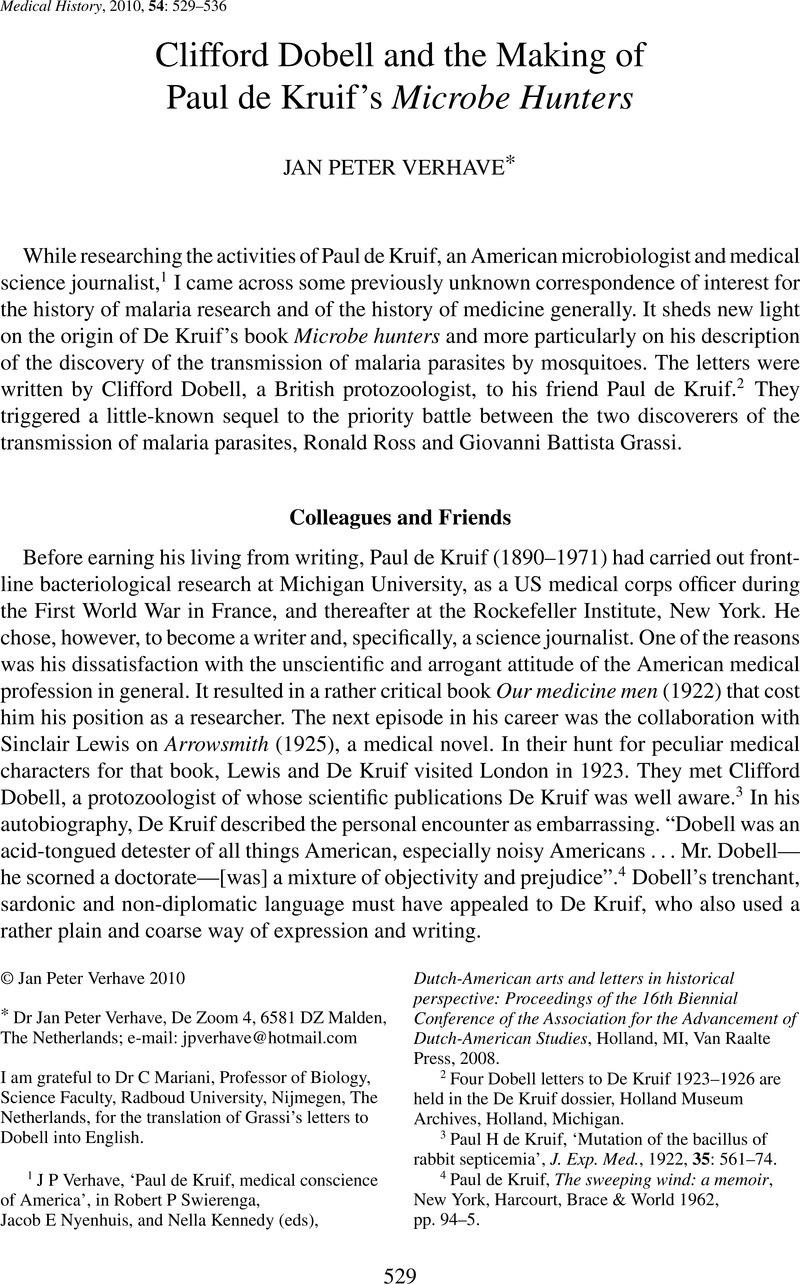Article contents
Clifford Dobell and the Making of Paul de Kruif's Microbe Hunters
Published online by Cambridge University Press: 17 May 2012
Abstract

- Type
- Short Articles
- Information
- Copyright
- Copyright © The Author(s) 2010. Published by Cambridge University Press
References
1 J P Verhave, ‘Paul de Kruif, medical conscience of America’, in Robert P Swierenga, Jacob E Nyenhuis, and Nella Kennedy (eds), Dutch-American arts and letters in historical perspective: Proceedings of the 16th Biennial Conference of the Association for the Advancement of Dutch-American Studies, Holland, MI, Van Raalte Press, 2008.
2 Four Dobell letters to De Kruif 1923–1926 are held in the De Kruif dossier, Holland Museum Archives, Holland, Michigan.
3 Paul H de Kruif, ‘Mutation of the bacillus of rabbit septicemia’, J. Exp. Med., 1922, 35: 561–74.
4 Paul de Kruif, The sweeping wind: a memoir, New York, Harcourt, Brace & World 1962, pp. 94–5.
5 Paul de Kruif, ‘I collect people’, Ladies’ Home Journal, Oct. 1941, pp. 129–33.
6 Clifford Dobell published his research in 1932: Antony van Leeuwenhoek and his ‘little animals’, London, J Bale, and New York, Harcourt, Brace, 1932.
7 Sir Ronald Ross, Memoirs: with a full account of the great malaria problem and its solution, London, John Murray, 1923.
8 Fielding H Garrison, An introduction to the history of medicine, 3rd ed., Philadelphia, W B Saunders, 1921.
9 Battista Grassi, ‘The transmission of human malaria’, Nature, 1 March 1924, 113: 304–6; idem, Nature, 29 March 1924, 113: 458.
10 The correspondence between Dobell and Grassi is kept in the Wellcome Library, London, Archives and Manuscripts, MSS 6041-5.
11 Letter from Dobell to De Kruif, London, 16 April 1925, de Kruif dossier, Holland Museum Archives.
12 Clifford Dobell, ‘Obituary: Prof. B. Grassi’, Nature, 1925, 116: 105–6, on p. 106.
13 The first professional translation of Grassi's Documenti riguardanti la storia della scoperto del modo di trasmissione della malaria umana, Milan, A Rancati, 1903, in the De Kruif dossier, Holland Museum Archives, Holland, Michigan: ‘Documentary evidences on how the way of transmission of the human malaria was discovered’. Dedicated to Patrick Manson (Ross was not amused by this); see P Manson, ‘Professor Grassi's recent pamphlet’, Lancet, 1903, i: 923; W F Bynum and Caroline Overy (eds), The beast in the mosquito: the correspondence of Ronald Ross and Patrick Manson, Amsterdam and Atlanta, Rodopi, 1998, letters 230–234.
14 Paul de Kruif, Microbe hunters, New York, Blue Ribbon Books, 1926, p. 279.
15 Bernardino Fantini, ‘The concept of specificity and the Italian contribution to the discovery of the malaria transmission cycle’, Parassitologia, 1999, 41: 39–47.
16 Bynum and Overy (eds), op. cit., note 13 above, letters 230–234.
17 Philip Manson-Bahr, ‘The story of malaria: the drama and actors’, Int. Rev. Trop. Med., 1963, 2: 329–90.
18 De Kruif, op. cit., note 14 above, pp. 286, 287, 298. [6pt]
19 Ronald Ross, ‘Simian journalism’, J. Trop. Med. Hyg., 1926, 29: 335–7, p. 337.
20 A Castellani, G C Low, D Nabarro and R Ross, ‘Disclaimer’, Br. Med. J., 2 Oct. 1926, ii: 617; idem, ‘A public denial’, Lancet, 1926, ii, 729; JAMA, 1926, 87: 1321.
21 Also chapter 9 on the discovery of trypanosomes as the agents of sleeping sickness was left out, due to protests of the above four (note 20), plus C Christy.
22 Letter from De Kruif to the editor of JAMA, 15 Oct. 1926, De Kruif dossier, Holland Museum Archives. Idem, JAMA, 1927, 88: 1097–98.
23 Current comment, ‘The facts of science’, JAMA, 1926, 87: 1307–8.
24 Eli Chernin, ‘Paul de Kruif's Microbe Hunters and an outraged Ronald Ross’, Rev. Infect. Dis., 1988, 10: 661–7. [6pt]
25 Edwin R Nye and Mary E Gibson, Ronald Ross, malariologist and polymath: a biography, London, Macmillan, and New York, St Martin's Press, 1997.
26 Eli Chernin, ‘Sir Ronald Ross vs. Sir Patrick Manson: a matter of libel’, J. Hist. Med. Allied Sci., 1988, 43: 262–74.
27 Letter from Dobell to De Kruif, 16 April 1925, Holland Museum Archives.
28 De Kruif, op. cit., note 4 above, p. 160.
29 Dobell, op. cit., note 6 above. De Kruif was one of two friends to whom the book was dedicated: “Fraterculo aeque caro nothoque Paul de Kruif Americano”.
30 Correspondence between De Kruif and Raymond Pearl, and De Kruif and Morris Fishbein. Raymond Pearl Papers, American Philosophical Society Library, Philadelphia, series 1, box 4; and Morris Fishbein Papers, University of Chicago Library, Special Collections Research Center, box 2, folder 1.
31 Clifford Dobell, ‘A text-book of unapplied biology’, Nature, 1936, 138: 523–5, on p. 525. The British publisher was Jonathan Cape.
32 Brian J Ford, ‘The Leeuwenhoekiana of Clifford Dobel (1886–1949)’, Notes Rec. R. Soc., 1986, 41: 95–105. Most of Dobell's other paper legacy was destroyed (personal communication from Professor Brian Ford, Jan. 2009).
33 The Annals of Medical History was established in 1917, and the American Association for the History of Medicine was founded in 1924.
34 Chernin, op. cit., note 24 above.
35 Paul F Russell, Man's mastery of malaria, Oxford University Press, 1955, Manson-Bahr, op. cit., note 17 above; Gordon Harrison, Mosquitoes, malaria and man: a history of the hostilities since 1880, London, Murray, 1978; Nye and Gibson, [16pc] op. cit., note 25 above; Bynum and Overy (eds), op. cit., note 14 above. There is one exception: R Ottaviani, D Vanni and P Vanni, ‘The centenary of G. B. Grassi's discovery’, Int. J. Anthropol., 1998, 13: 177–9.
36 Letter from Dobell to De Kruif, 16 April 1925, Holland Museum Archives.
37 William C Summers, ‘Microbe hunters revisited’, Int. Microbiol., 1998, 1: 65–8.
- 1
- Cited by


